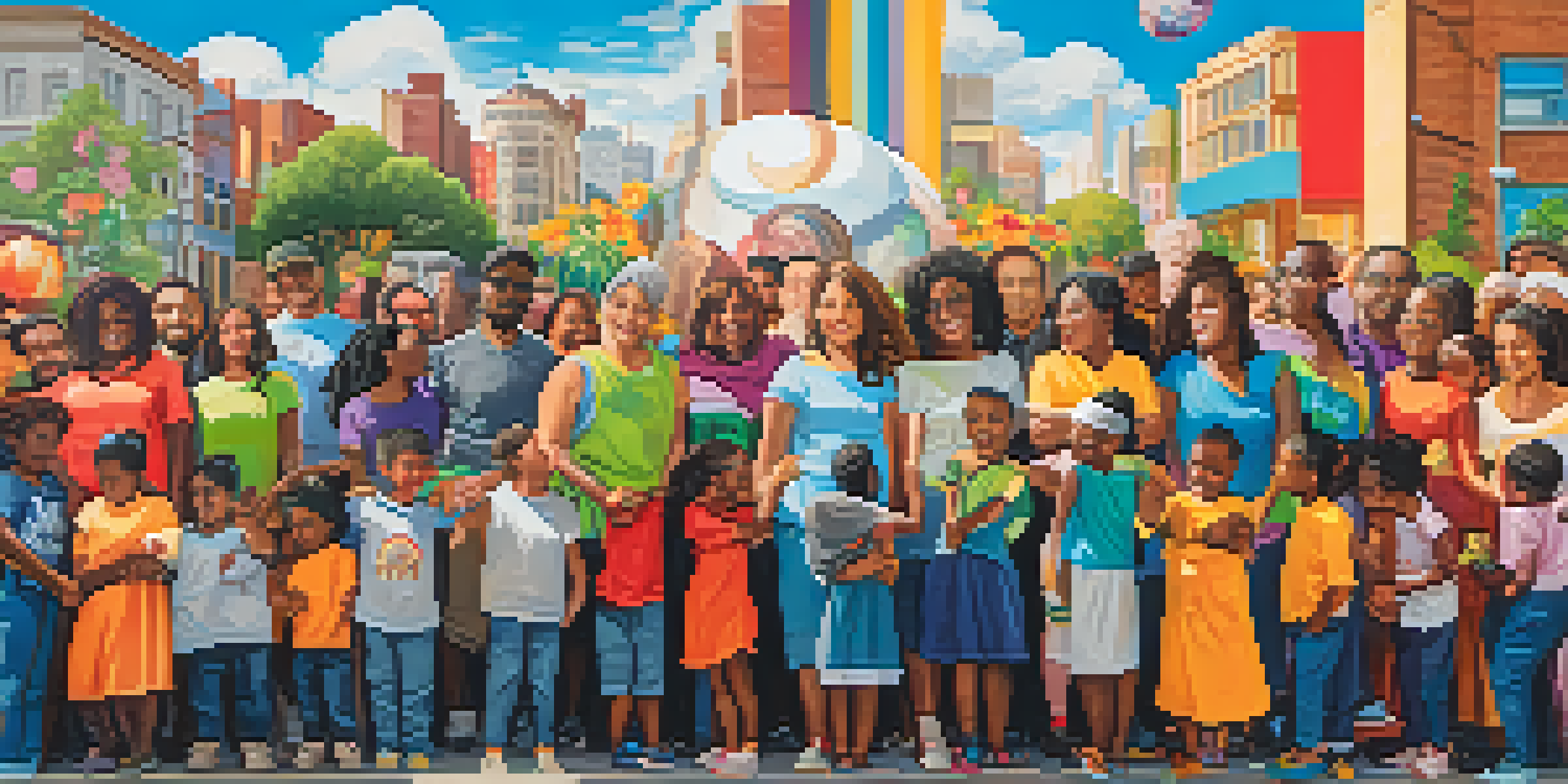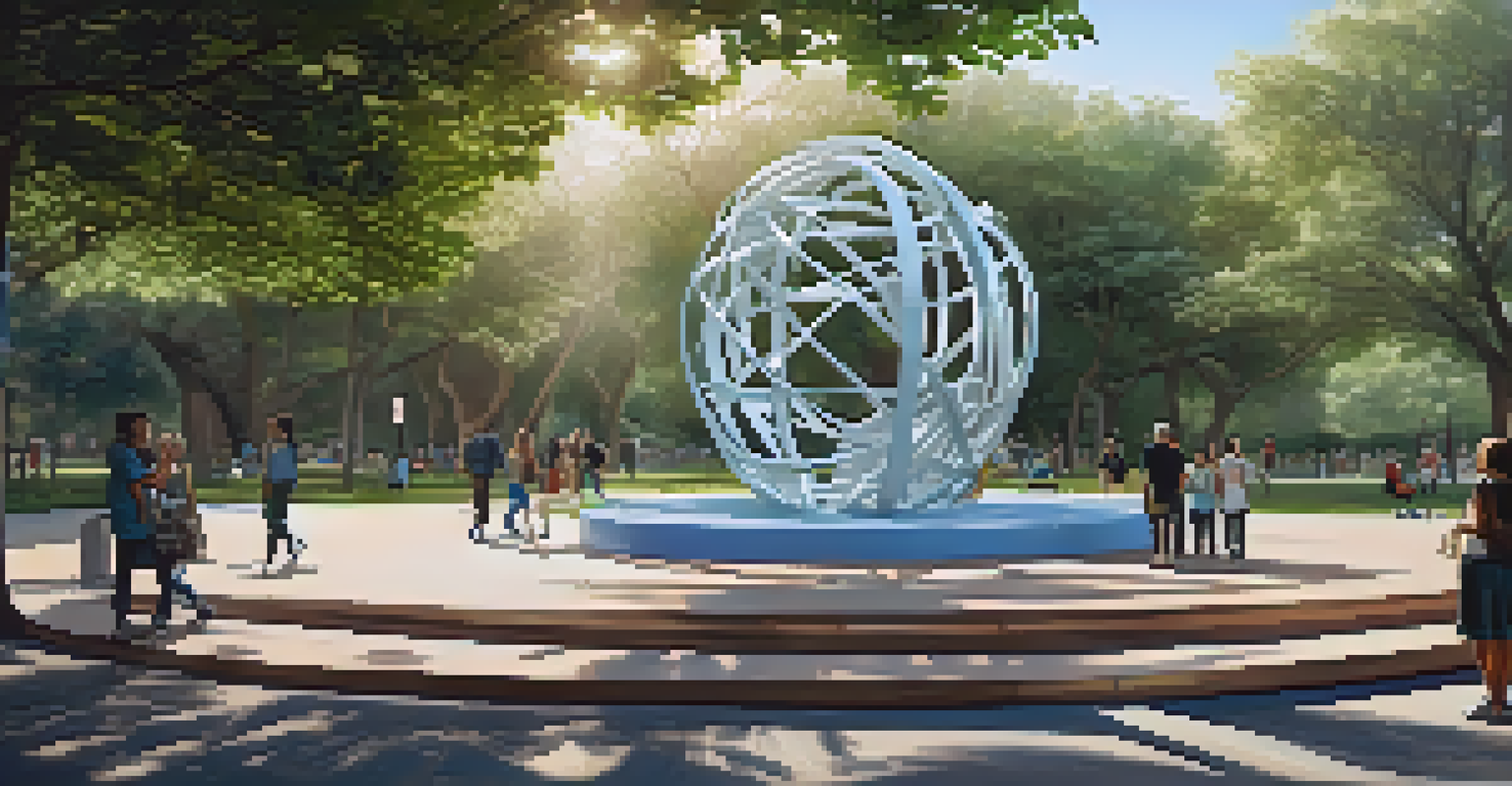The Intersection of Art and Activism in Community Building

Understanding the Role of Art in Activism
Art has always been a powerful tool for expression, especially in activism. It allows people to convey complex emotions and ideas that might be difficult to articulate through words alone. From murals to performances, art can challenge societal norms and inspire change.
Art is not a mirror to reflect the world, but a hammer with which to shape it.
For instance, consider the vibrant murals found in cities; they often tell stories of struggle, hope, and resilience. These visual narratives can unite communities by creating a shared experience and fostering dialogue. In essence, art becomes a voice for the voiceless, making activism more relatable and engaging.
Moreover, art can serve as a catalyst for gathering people around a common cause. Whether it’s a community art project or a public performance, these creative expressions can draw attention to pressing issues, mobilizing individuals to take action.
The Power of Community Engagement through Art
Community engagement is at the heart of effective activism, and art can bridge the gap between individuals and collective action. When community members participate in creating art, they invest in the outcome, fostering a sense of ownership and pride. This collaborative spirit can strengthen community bonds.

Take, for example, community art festivals that bring people together to create public artworks. These events not only beautify neighborhoods but also encourage conversations about local issues, helping to identify solutions. When people come together to create, they often discover shared values and goals.
Art Amplifies Activism's Voice
Art serves as a powerful medium for expressing complex emotions and ideas, making activism more relatable and engaging.
Additionally, art can make activism more accessible. By engaging diverse groups in creative processes, barriers are lowered, and everyone’s voice has the opportunity to be heard. This inclusivity is essential for building a robust community that fully represents its members.
Art as a Medium for Social Justice Movements
Throughout history, art has played a significant role in social justice movements. Artists have used their craft to shine a light on injustices, call for change, and inspire action. Whether it's through protest songs or powerful imagery, art has the ability to resonate deeply with audiences.
The purpose of art is not a rarified, intellectual distillate; it is life, intensified, brilliant life.
For example, during the civil rights movement, music, poetry, and visual art were crucial for mobilizing support and raising awareness. These artistic expressions not only unified activists but also reached those who might not have otherwise engaged with the movement. This illustrates how art can transcend barriers and create empathy.
In today's world, social media amplifies this effect, allowing artists to share their messages with a global audience. This instant access can generate widespread support for social justice initiatives, proving that art remains an essential tool for advocacy.
The Impact of Public Art Installations
Public art installations serve as a powerful medium for activism, transforming everyday spaces into canvases for change. These installations often provoke thought and stimulate conversations among passersby, making them a vital part of community engagement. When art is in public spaces, it becomes accessible to everyone.
Consider how a thought-provoking sculpture or an interactive mural can invite viewers to reflect on social issues like poverty or climate change. These installations not only beautify the environment but also challenge individuals to engage with important topics. They can spark curiosity and motivate people to learn more.
Community Engagement Builds Unity
Collaborative art projects foster a sense of ownership and pride, strengthening community bonds and promoting collective action.
Moreover, public art can create a sense of belonging and pride within communities. When residents see their stories and struggles represented, it fosters a deeper connection to their surroundings and encourages active participation in local initiatives.
Storytelling through Artistic Expression
Storytelling is an age-old tradition, and when combined with artistic expression, it becomes a potent tool for activism. Narratives conveyed through art can highlight personal experiences, shedding light on broader societal issues. This storytelling aspect allows audiences to connect with the subject matter on a deeper level.
For instance, spoken word poetry can give voice to marginalized communities, sharing their struggles and triumphs. This form of art not only entertains but also educates and inspires action. When people hear these authentic voices, they are more likely to empathize and support the cause.
Additionally, storytelling through art can create a sense of urgency around social issues. By illustrating the real-life impacts of these challenges, artists can motivate individuals to take a stand and advocate for change.
Collaborative Art Projects that Promote Unity
Collaborative art projects are fantastic ways to bring communities together, allowing participants to share their stories and perspectives. These projects often encourage cooperation and teamwork, fostering unity among diverse groups. When individuals work together creatively, they build trust and understanding.
An example of this is a community quilt project where each participant creates a square representing their personal journey. The final product not only showcases individual stories but also symbolizes the strength of the community as a whole. Such projects can create lasting memories and connections among participants.
Storytelling Drives Social Change
Through artistic expression and storytelling, artists can highlight personal experiences and motivate audiences to advocate for social justice.
Moreover, collaborative art can lead to the development of new ideas and solutions. As community members share their perspectives through art, they may discover common ground that can lead to innovative approaches to local challenges.
The Future of Art and Activism in Community Building
As we look to the future, the intersection of art and activism will continue to evolve, particularly with the rise of technology. Digital platforms are providing artists with new ways to engage audiences and promote social change. This opens up exciting possibilities for community building in the digital age.
For instance, virtual reality experiences can immerse individuals in stories and environments, fostering empathy for different perspectives. This innovative approach can reach wider audiences, expanding the impact of artistic activism. Technology allows for unique collaborations that can cross geographic boundaries.

Ultimately, the future of art and activism lies in collaboration and inclusivity. By embracing diverse voices and creative expressions, communities can create a more vibrant and equitable world, ensuring that art remains a vital force for change.